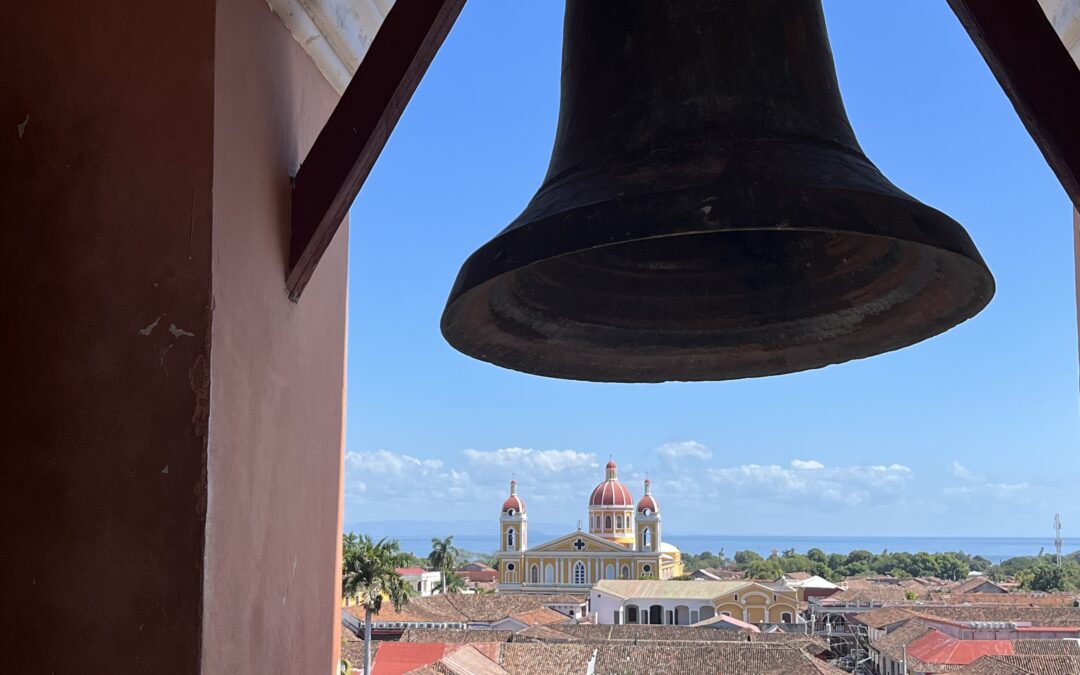Pirates and volcanos in Colonial Granada
Outside Selina’s front gate, I hoist myself into the weather-beaten pickup bed of my 4X4 transport and brace against the twisting, spine fusing passage to San Juan del Sur’s terminal. I’m dinged up from overworked rotator cuffs and bad wipeouts. The chicken bus to Granada embarks straight up Nicaragua’s land belt along Lake Nicaragua. Children immaculately clad in Catholic school uniforms, carrying colorful backpacks, are escorted by svelte young mothers, high cheekboned and almond eyed, shiny dark hair in tidy buns. The soft early sun along the dusty gravel road gives way to searing heat.
The Granada bus terminal is walking distance to my destination, but the heat disorientates me. A kind local man helps the cab driver pinpoint my target and validates one US dollar is an honest fare. We whisk through mango, raspberry and lime blurred passageways, and stop at a lavender and white trimmed façade. Horse drawn carriages traverse narrow cobblestone streets lined with terra cotta roofed homes with massive arched doors of old timber. My proprietors, Carlos and Marlies are regal and cordial. Carlos books my day tours and elegant Marlies acclimates me to Granada’s cultivated dining scene.
Away from the city center to the east, the horse-drawn carriages set an unhurried pace. Gringo street, the pedestrian walkway just off the main square, encompasses all manner of people happily strolling, perusing local street seller wares and enjoying Granada’s quality of cuisine. I savor Calle la Calzada’s sultry, tropical ambiance. Standing at the sea wall with locals I fix my eyes on the waves breaking on the gray beach. This is where English, French and Dutch pirates found their way up the San Juan River, and the city was raided, razed, and rebuilt for hundreds of years.
Captain Henry Morgan, a remarkable leader and fearsome conqueror, floated six shallow draft canoes inland up the San Juan River across vast Lake Nicaragua under cover of darkness to raid Granada. A solitary cannon off the plaza’s northeast corner marks where Morgan set off 18 cannons, malevolently overthrowing the city; setting the buildings ablaze, sinking all of the Spanish ships in the port and escaping up the Coco River with 500,000 sterling silver pounds.
Three-hundred-sixty years later, as the mid-day heat sets in, I look out on the same harbor Captain Morgan ruthlessly took by surprise. How serene the harbor is today with vendors peddling brightly colored drinks of fruit and water with ice in plastic bags. They place a straw in the bags and tape them up.
I’m up and about in early Sunday stillness roaming the colorful streets plundered by pirates and filibusters. I can’t walk by Antiguo Convento San Francisco church without going in. It was built in 1626. The interior is cool and hushed. The walls and high ceiling are yellow with brilliant white molding. I stay for Mass. The un-cushioned kneelers pressing into my tibias remind me I’m in a very old space. The heartfelt reverence of the Nicaraguan people grips me. The Ortega-Murillo regime is forcing everyone to wear masks inside the church. Since I don’t have one, I waste no time departing at the end of the Mass.
In 1854 Iglesia of Merced church was occupied by William Walker for 18 days as one of his last strongholds. Walker, an unauthorized U.S. adventurer, or “filibuster,” led armed expeditions to Latin America in the 19th century, declared himself president in 1856 and tried to impose slavery. When Walker was forced from power, he instructed his men to burn Granada. Walker was eventually turned over to Honduran authorities who executed him by firing squad in 1857. Along with many of Granada’s landmarks, Iglesia of Merced has been destroyed and rebuilt a number of times in the centuries since. There is a bell tower I want to climb for views from high above the busy streets of Granada but I push on to Inglesia Guadelupe.
Originally completed in 1539, poignant Inglesia Guadelupe is one of the oldest churches in Central America. Captain Henry Morgan set it on fire in 1670. In 1856, Willian Walker added it to churches in Granada he managed to set on fire. Within its crumbling and blackened façade, my petitions converge with those of pilgrims going back over 500 years. The caretaker pauses his duties to permit my entry to the bell tower. I climb the steep, winding stairs. The bell tower window framed view is resplendent. Beyond Inglesia Guadelupe’s terra cotta rooftop, Granada Cathedral soars above the plaza and commands the skyline. Lake Nicaragua sparkles against sapphire sky with the islets and Zapatera island not far from the shore. Mombacho Volcano, known as the “Sultan”, rises 1434 yards above sea level.
Granada’s colorful dwellings are fairly plain on the outside save their magnificent doors. Along the narrow sidewalks I’m a mere arm’s length from vivid black and white tilework, vaulted wood beam ceilings, sprawling corridors and sumptuous open courtyards. I can’t help myself from peering into hushed, intimate interiors. Mahogany rocking chairs, low set wood tables and ornately detailed desks gleam in evening luminosity. The sky fills with stars. A minuscule breeze wafts through. Neighbors – impervious to relentless mosquitos – relax on rocking chairs in front of their houses.
Most of the houses were built after William Walker burned Nicaragua in 1857. But the streets. The streets that led Caribbean raiders to their helpless targets are mine to pursue their eerie pathways.

